Bill Haley and His Comets’ “Rock Around the Clock” raised the curtain on the age of rock, a jarring (for its time) but highly danceable tune featured in the film Blackboard Jungle in 1955. With the release of the movie, the song vaulted to number one on the Top 40 and stayed there for eight weeks.
It pulsated urban rhythm, a perfect accompaniment to the movie’s lurid depiction of juvenile delinquency — the “teenage savages who turn big-city schools into a clawing jungle,” as the narrator intoned in the trailer.
The sound was raw, primal. It hardly mattered that Haley with his trademark spit-curl hairstyle grew up in small-town Pennsylvania and the band performed in matching sport coats.
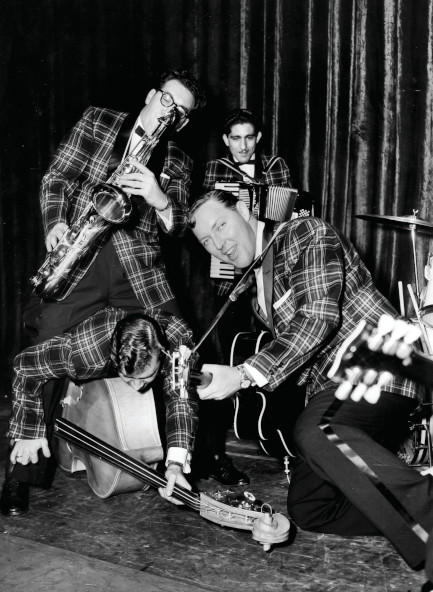
So it is no surprise that even today “Rock Around the Clock” is often cited as America’s first rock ’n’ roll song. With its launch, “a dam had burst,” the New Yorker wrote in a 2015 story marking the song’s 60th anniversary.
It went on to dominate the Billboard pop chart, a space hitherto reserved for the McGuire Sisters, Patti Page, and other singers emblematic of America’s post-war search for reassuring normality.
Was “Rock Around the Clock” truly the first rock ’n’ roll hit? Its impact was undeniable, but many rock connoisseurs and critics say it was not the first, and at best may have been derivative of earlier rock-type hits. The Rock and Roll Hall of Fame credits the 1951 single “Rocket 88” as number one of rock’s number ones. The song is credited to Jackie Brenston and His Delta Cats. (Brenston was Ike Turner’s saxophonist, and the Delta Cats were Turner’s backup band. Brenston sang the lead vocal and is listed as the songwriter, but Turner is the actual author of the song.)
Not everyone agrees that there even was a “first” rock hit. The phenomenon that set rock ’n’ roll in motion “took place over time,” says Kenny Vance, singer in Jay & the Americans on all their 1960s hits, including “Cara Mia” and “Come a Little Bit Closer.” He points out that records by Black artists, that had been marketed mainly to Black adults, started becoming increasingly popular with white teenagers in the early 1950s — and it’s probably no coincidence that this was also when the civil rights movement was being born.
Record executives were puzzled at first at the surge in sales of Black music, says Vance, a student of rock history who today leads his own vocal group, The Planotones. “No one really knew why. But when they realized [they were] selling to the mainstream teenage market, it created a revolution.”
Mark Naison, professor of African-American history at Fordham University, calls white-teen consumption of Black music the industry’s “big bang.”
“What you had on the airwaves was African-American popular music with an upbeat message, conspicuously danceable and also a little bit erotic,” Naison says. “As it got on the airwaves, young white guys started listening to this music, liking it, and started going to Black neighborhoods to buy it. What some entrepreneurial-minded people began to realize was ‘man, if we could sell this as a non-racial music, we could make a fortune!’”
Looking back, it’s hard to ignore the parallel tracks of the surge in rock music popularity and the growth of the civil rights movement. One was cultural and economic, the other was political and social. But in many ways they arrived at the same station at the same time. “I wouldn’t want to make it seem like this was part of the civil rights movement, because it was motivated by money, sex, fun,” Naison says. “Race was almost never mentioned in these songs, but they brought together whites, Blacks, and Latinos in settings where they didn’t previously connect.”
It’s significant that rock music in those early days was mostly doo-wop, so called because of its nonsense lyrics, lines like “Do-Bopsy-Do” and “Uhlee-Popa-Kah-Popa-Kah.” It actually had deep roots in the history of African-American music, growing out of the long tradition of gospel harmony singing by groups like the Pilgrim Travelers and the Golden Gate Quartet.
Doo-wop came of age in an era of relative prosperity for African Americans in northern cities. Despite racism, segregation, and inner-city poverty, Black workers had prospered in union jobs during World War II. After the war, African Americans had enough disposable income to underwrite not only Black-oriented companies like the legendary Atlantic Records, but also the clubs and radio stations — the economic underpinnings of doo-wop.
Even though doo-wop didn’t have “a political bone in its body” as Naison notes, some white parents actually found these mysterious lyrics threatening — even starting movements to ban “jungle music” from the airwaves. Sherman Garnes, Frankie Lymon and the Teenagers’ giant (6-foot-6) bass singer, may have served up the group’s collective response in singing “I’m not a juvenile delinquent!” at the start of one song. But concerned white parents and would-be censors never had a chance against the music’s compelling appeal to yearning white teens.
At first, the record industry relied on saccharine white-cover versions of Black hits in its attempts to profit from the crossover trend. “Sh-Boom,” a bass- and sax-laden hit for the Chords, was transformed into a light-harmony ditty by The Crew-Cuts singing a chorus of “Sh-boom sh-boom, ya-da-da da-da-da da-da-da da.”
Other Black songs, like “Sincerely” by the Moonglows, got a similar treatment when covered by the McGuire Sisters. But by the end of 1955, after 13-year-old Frankie Lymon’s “Why Do Fools Fall in Love” reached the Top 10 and earned him and the Teenagers a spot in Alan Freed’s movie Rock, Rock, Rock!, Black vocal groups themselves began to step front and center.
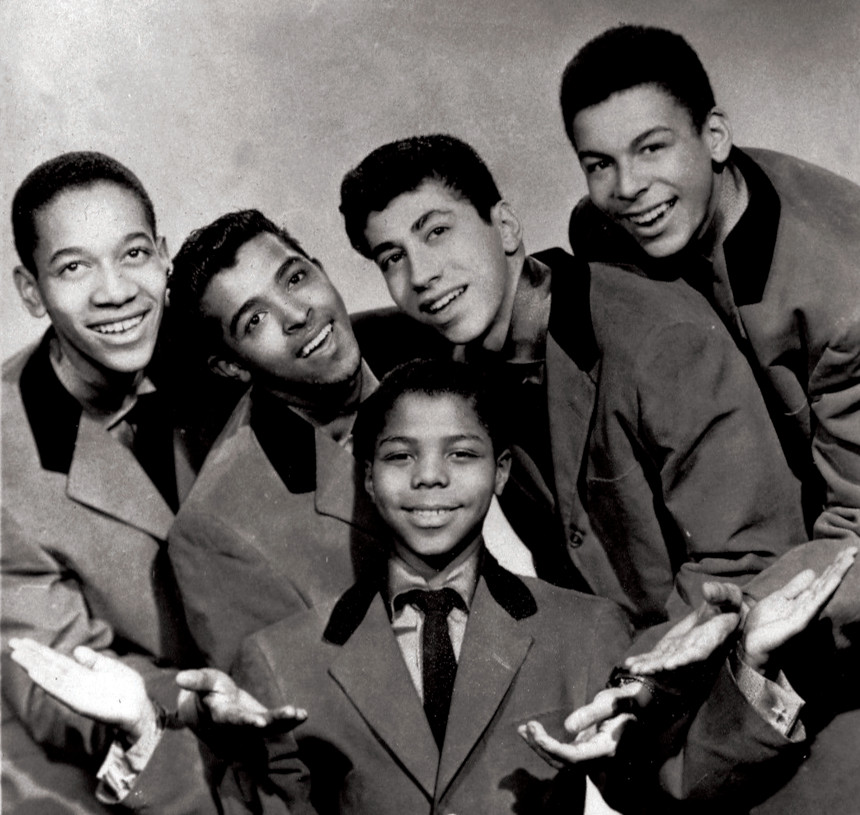
So, with mid-century cultural forces in play, the rise of rock may have been inevitable. And despite the ongoing debate about “Rock Around the Clock,” it may be impossible to name the single song that “started” rock ’n’ roll. But Freed arguably did more than any single individual to turn it into a cultural juggernaut, including coining the actual phrase (based on “I rock ’em, roll ’em all night long,” from the R&B hit “60 Minute Man” by Billy Ward and the Dominoes, the first Black R&B song to break the white-dominated pop chart).
A lively D.J. and energetic promotor, Freed started playing all-Black R&B in Cleveland in 1951 at the behest of a local record store owner who noticed the uptick of R&B sales to white teenagers. The show, along with Freed’s live events, was so successful that Freed was able to bring his formula to New York’s AM powerhouse station WINS in 1954. The frequency and market power of WINS eclipsed the lower-powered stations, so the music, now heard by many for the first time, seemed new and revolutionary — even if it wasn’t. While New York was ground zero of sorts, the rock ’n’ roll revolution also caught fire in Philadelphia, Pittsburgh, Chicago, Los Angeles, and numerous other American cities.
Doo-wop, of course, was not the only ingredient in the rock ’n’ roll mix. Sam Phillips’ legendary Sun Records in Memphis recorded Elvis Presley, Carl Perkins, and Jerry Lee Lewis — twangy Southern-sounding music that also was in part derived from Black music like “Rocket 88” (also recorded by Phillips).
Elvis’s first hit, “Hound Dog,” in 1956 actually was a cover of the original by Big Mama Thornton. Chuck Berry and Little Richard formed their own tributaries, all of which flowed into the river of what became rock ’n’ roll. “It all got marketed together; look at American Bandstand,” says Naison, referring to Dick Clark’s TV show from Philadelphia that did so much to solidify rock’s dominance. “Everybody got there. It was all music to be danced to.”
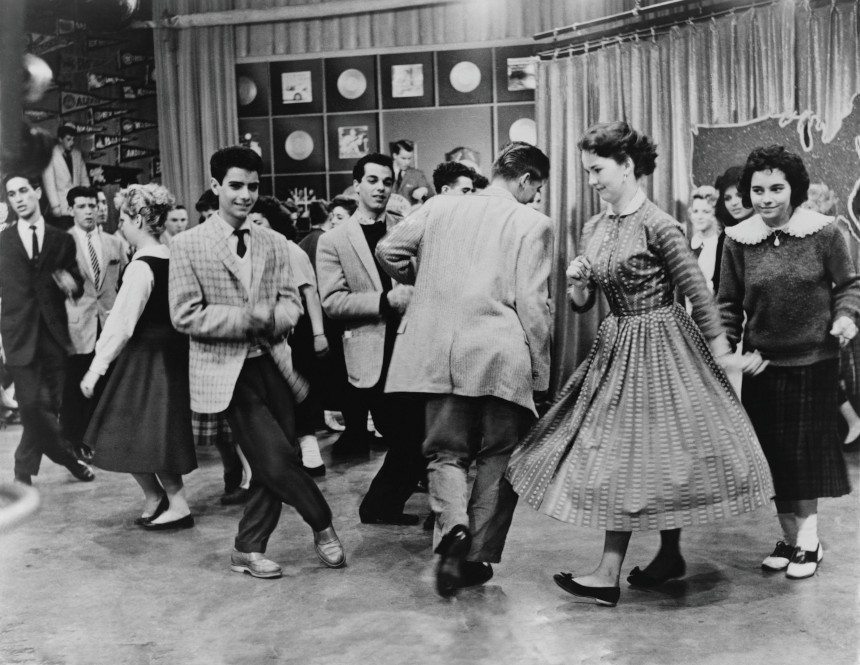
Actually, not everyone “got there.” Few groups survived the “one-hit wonder” stage, and their members were forced back into jobs as school janitors or bus drivers. Unscrupulous promoters attached their own names to songs they did not write, garnering royalties they didn’t deserve. The groups themselves often saw little or no money until litigation decades later won some of it back.
In 1961, Barry Mann, a white Brill-Building type singer-songwriter, scored a hit with a parody of the doo-wop era, “Who Put the Bomp.”
When my baby heard “Bomp bah bah bomp bah bomp bah bomp bomp”
Every word went right into her heart
And when she heard them singin’
“Rama lama lama lama lama ding dong”
She said we’d never have to part.
Although Mann’s singing voice dripped with barely concealed sarcasm, the song became a hit precisely because it emulated the doo-wop formula so well. It was a perfect coda to rock ’n’ roll’s opening movement.
Dan Freedman was longtime regional correspondent at Hearst Washington Bureau and is currently senior editor at Moment Magazine.
This article is featured in the January/February 2022 issue of The Saturday Evening Post. Subscribe to the magazine for more art, inspiring stories, fiction, humor, and features from our archives.
Featured image: Excavating rock: Cultural historians say rock ’n’ roll went mainstream after white teens began consuming Black music in the early ’50s. “Rocket 88,” written by Ike Turner (in white suit), was the first rock hit, according to the Rock and Roll Hall of Fame. (Southern Stock Photo / Alamy Stock Photo)
Become a Saturday Evening Post member and enjoy unlimited access. Subscribe now
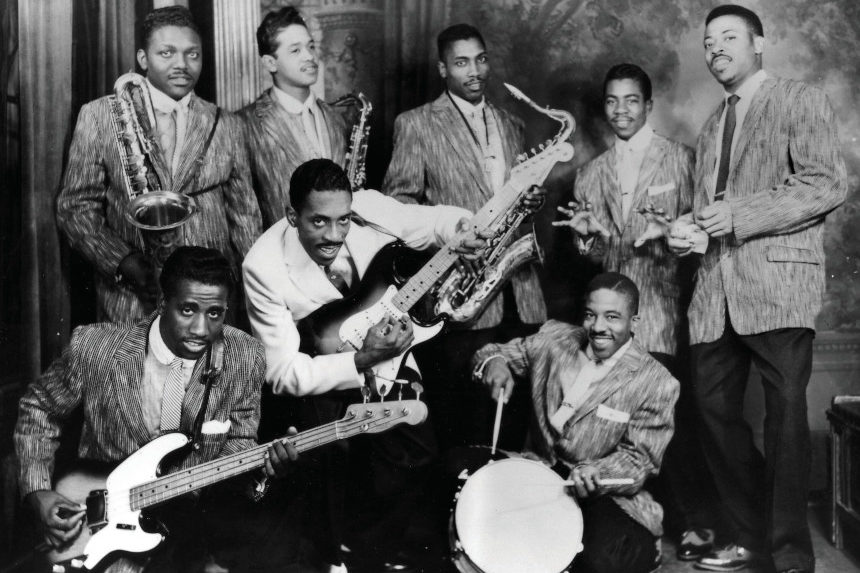
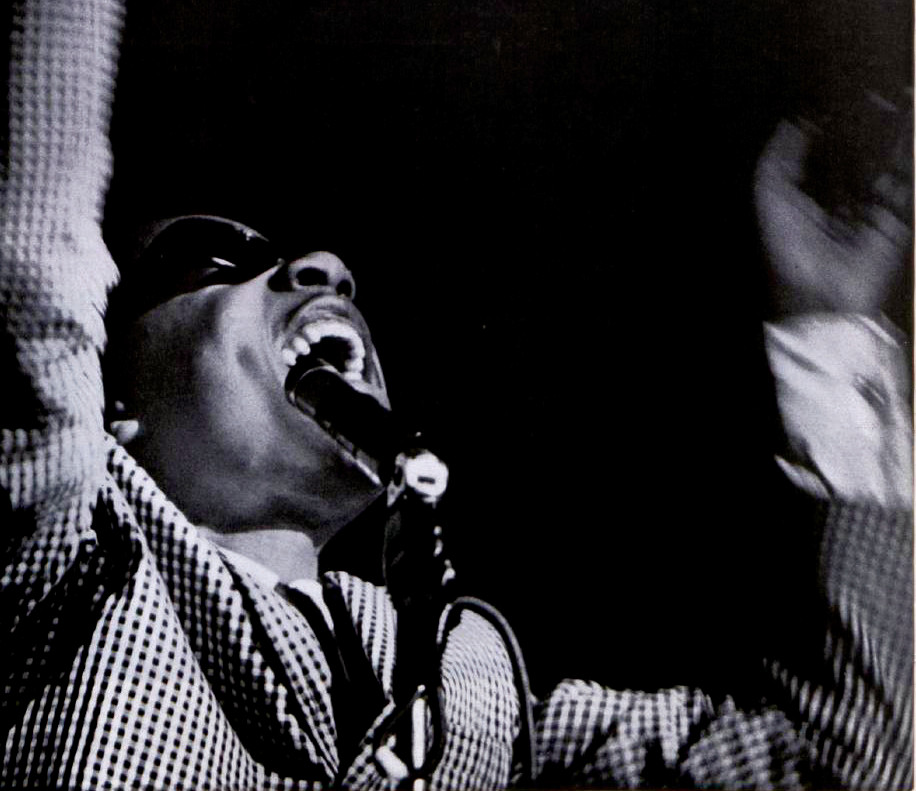


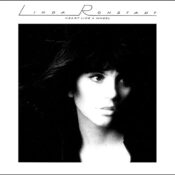
Comments
I agree with Sarah and Daphne here. Great music is great music regardless of the race of an individual singer or the group. Motown proved that over and over again with groups like The Flamingos (I Only Have Eyes for You) amazing Doo Wop, Smokey Robinson & The Miracles (Shop Around), The Marveletttes (Please Mr. Postman), The Chiffons (One Fine Day) written by Carole King, also incredible Doo Wop, The Temptations (Get Ready), The Four Tops (I’ll Be Around), Diana Ross and the Supremes; too many hits to mention here, but… how about ‘The Happening’? Stevie Wonder, Curtis Mayfield, Gladys Knight, Roberta Flack, Donna Summer?
This is just a small sampling of the hits by these and other Motown artists. It was more than just the music. Visually the clothes, hair styles and of course the perfect dance moves have never been duplicated before or since. This is not to say there weren’t some great white singers or groups either. The Searchers (Love Potion #9) from 1963 were brilliant in their state-of-the-art sound combining some of of the ‘surf rock’ sounds of The Chantays and the Beach Boys with rock & some remaining ties to Doo Wop.
Then the Beatles came along. They were, and are still as great as ever to listen to. Still, one has admit they kind of sucked a lot of air out of the room at the time—-not their fault, and wonder which group would have reigned supreme. God only knows for sure, but it probably would have been The Beach Boys.
So much great music (like films and auto design) packed into the 1950s to mid=80’s, then mostly gone. The 5th Dimension is an example of a Motown group that sounded ‘white’ but were not. Did it matter then? No, thank God! If they were the same ages they were in 1968 today, they’d never get a record contract. They would be “cancelled” before they could do anything. No “Up, Up and Away”, “Aquarius” or “Last Night I Didn’t Get to Sleep At All.”
Actually, there are plenty of white singers that would never get record contracts today for not conforming to the singular “American Idol” style that’s here permanently. Nancy Sinatra? Deborah Harry? Pat Benatar, for starters? No way, Jose.
Great article and my past research, while pursuing my degree from The University of Alabama concurs that “Rocket 88” was indeed the first recognized R & R song and it was a moderate hit. I encourage anyone who has not listened to this song to do so. It is awesome! Check it out: https://www.youtube.com/watch?v=Gbfnh1oVTk0.
Although if you have really listened and studied Hank Williams, Sr. you will see some of his music could fall into the category of early R & R or as some refer to as “Rockabilly.” Many of his hits have been covered in later years by the likes of George Thorogood and the Delaware Destroyers (“Move it on Over”), B.J. Thomas (“I’m So Lonesome I Could Cry”), and John Fogerty’s Blue Ridge Rangers (“Jambalaya”) just to name a few. Incidentally, these were great remakes….My apologies for getting off the subject…Sorry.
I’m in my 80s now and lived through all the R&R days in the article. As a white, teenaged girl who had no tv until 1956 and listened to the radio, I had no idea I was listening to groups of Black musicians. It didn’t matter who was singing. We just loved the music.
Sarah B. Miller is right about Motown. I remember hearing early Motown circa 1962 and being quite taken with it. Inasmuch as I’m white, I felt a smugness in regard to my nine year old friends, whom I knew didn’t listen to that sort of thing.
You can hear the soft breathing of baby Rock as far back as the late 30s/early 40s, with things such as Basie’s One o’Clock Jump and Artie Shaw’s Summit Ridge Drive, but I contend that the first real rock recording was Louis Jordan’s Saturday Night Fish Fry. I’m not sure whether that precedes Rocket 88, but have a hunch that it might, by a year or so.
@Sarah B Miller: Same here. I’m the same age as you and remember winning a transistor radio in a Cub Scout contest. Wore out a lot of 9volt batteries. Also, my father was a jazz musician so I got introduced way early to swing.
Grew up in the 60s and early 70s with “Motown” music. Was absolutely the best music then and continues to be today. At 70 years old, it takes me back every time…nothing better!
Thank you for the article…an interesting read.